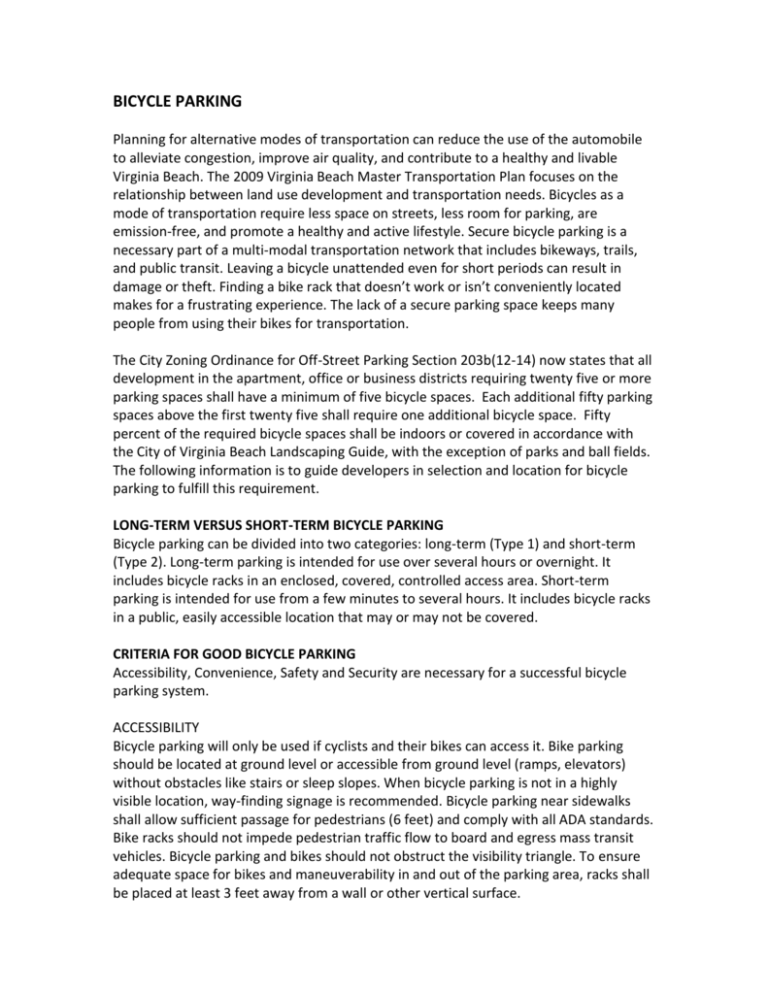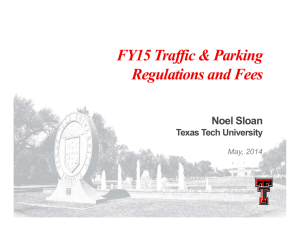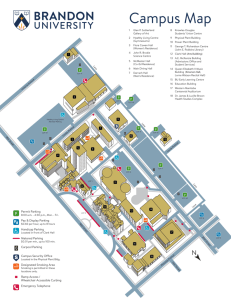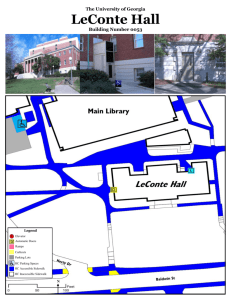Bicycle_Fact_Sheet_04
advertisement

BICYCLE PARKING Planning for alternative modes of transportation can reduce the use of the automobile to alleviate congestion, improve air quality, and contribute to a healthy and livable Virginia Beach. The 2009 Virginia Beach Master Transportation Plan focuses on the relationship between land use development and transportation needs. Bicycles as a mode of transportation require less space on streets, less room for parking, are emission-free, and promote a healthy and active lifestyle. Secure bicycle parking is a necessary part of a multi-modal transportation network that includes bikeways, trails, and public transit. Leaving a bicycle unattended even for short periods can result in damage or theft. Finding a bike rack that doesn’t work or isn’t conveniently located makes for a frustrating experience. The lack of a secure parking space keeps many people from using their bikes for transportation. The City Zoning Ordinance for Off-Street Parking Section 203b(12-14) now states that all development in the apartment, office or business districts requiring twenty five or more parking spaces shall have a minimum of five bicycle spaces. Each additional fifty parking spaces above the first twenty five shall require one additional bicycle space. Fifty percent of the required bicycle spaces shall be indoors or covered in accordance with the City of Virginia Beach Landscaping Guide, with the exception of parks and ball fields. The following information is to guide developers in selection and location for bicycle parking to fulfill this requirement. LONG-TERM VERSUS SHORT-TERM BICYCLE PARKING Bicycle parking can be divided into two categories: long-term (Type 1) and short-term (Type 2). Long-term parking is intended for use over several hours or overnight. It includes bicycle racks in an enclosed, covered, controlled access area. Short-term parking is intended for use from a few minutes to several hours. It includes bicycle racks in a public, easily accessible location that may or may not be covered. CRITERIA FOR GOOD BICYCLE PARKING Accessibility, Convenience, Safety and Security are necessary for a successful bicycle parking system. ACCESSIBILITY Bicycle parking will only be used if cyclists and their bikes can access it. Bike parking should be located at ground level or accessible from ground level (ramps, elevators) without obstacles like stairs or sleep slopes. When bicycle parking is not in a highly visible location, way-finding signage is recommended. Bicycle parking near sidewalks shall allow sufficient passage for pedestrians (6 feet) and comply with all ADA standards. Bike racks should not impede pedestrian traffic flow to board and egress mass transit vehicles. Bicycle parking and bikes should not obstruct the visibility triangle. To ensure adequate space for bikes and maneuverability in and out of the parking area, racks shall be placed at least 3 feet away from a wall or other vertical surface. CONVENIENCE Cyclists are most likely to use bicycle parking when it is close to their destination. Installing racks far from an entrance may encourage cyclists to lock their bike to a tree or piece of street furniture that is closer. Bicycle parking should be placed within 50 feet of the building entrance that cyclists use. Where there is more than one building on a site, or where a building has more than one main entrance, the parking shall be distributed to serve all buildings or main entrances. Wherever possible, situate bike racks close to bikeways and trails. SAFETY AND SECURITY Safety and security measures must be considered to encourage use of bicycle parking facilities. Racks and lockers should be made from high quality materials and firmly secured to the ground, floor, or wall of a well-lit area. Racks should be adequately anchored to discourage displacement or removal. Concrete is the preferred surface for maximum security, though other surfaces may also be appropriate. Short-term parking should be located in a busy, public area to increase informal surveillance, and long-term parking should be located in a separate access-controlled area. Adequate lighting must be installed for visibility at the bike parking site and any pathways to and from this area. ACCEPTABLE TYPES OF RACKS Secure bicycle parking allows the frame and one wheel to be locked to the rack when both wheels are left on the bike. A simple inverted U-rack is attractive, easy to use, and highly secure. The rack should provide two-point support of the bicycle and have no sharp edges. The rack should be usable by bikes with no kickstand and by a wide variety of sizes and types of bicycles. Racks that only secure the front wheel are not acceptable. Left: Examples of acceptable two-point support designs. Graphic from Las Cruces Proposed Bicycle Parking Design Standards. Preferred materials: Galvanized steel with powder coating requires little maintenance and provides a smooth surface that will not scratch or damage bicycle frames Materials to avoid: Wood, soft metals, untreated metals, cast components that are brittle and may crack on impact. For rack designs that have welded sections avoid materials like stainless steel that have weak welds. BICYCLE PARKING DIMENSIONS Adequate space is necessary to accommodate bicycles and maneuvering in and out of the bike parking area. At least 30” is required and 36” is recommended between bike racks placed side-by-side, and 60” is recommended between racks placed end to end. One inverted U-Rack counts as two parking spaces. Three feet is the suggested distance between a planted area and the outermost edge of a bike rack. Left: A 10’x18’ vehicular parking space can accommodate 6 inverted U-racks (12 bicycle parking spaces). Graphic from Las Cruces Proposed Bicycle Parking Design Standards. COVERED BICYCLE PARKING Prolonged exposure to precipitation can rust a bike’s frame and components; Ultraviolet rays from the sun deteriorate a bike’s soft seat and tires, as well as making the bike uncomfortable to ride on hot days. Covered bicycle parking will encourage use by cyclists who value their bicycle. Covered spaces can be standalone structures, roof overhangs, awnings, lockers, or bicycle storage www.downtownmedford.com spaces within buildings and parking garages. The cover must be permanent and secure. Overhead clearance should be at least 7’ to allow for maneuverability. Covers that are too high do not protect from rain, sun, and snow. The covered structure must use similar construction materials as the main building and be aesthetically complimentary to surrounding architecture and design elements. If freestanding, the structure must be at least 150 square feet and comply with all local building codes including drainage regulations. Several companies sell prefabricated bicycle shelter structures that fulfill City requirements. BICYCLE LOCKERS Bicycle lockers are individual storage units that are weather protected, enclosed, and operated by a controlled access system that may use keys, swipe card, or an electronic key pad located on the door. Cyclists can securely store their bike, helmet, and gear. Many models hold two bicycles, and have access doors at opposite ends of the locker. On average, one standard car parking space can accommodate five bicycle lockers, www.pp.msu.edu depending on the locker design. Stackable models can double bicycle parking capacity; however, the top lockers provide limited access to cyclists who cannot or choose not to lift their bike into the top locker unit. Bike lockers require a level, clean, surface and clearance for the door to easily open and close. Bike lockers are best placed away from sidewalks and areas with high pedestrian traffic. Like all bicycle parking, bike lockers should be placed close to building entrances, in a well-lit area with regular security surveillance. SUGGESTIONS Increase the use of your bike facility by incorporating non-required services and infrastructure into your bicycle parking system. Include a local bike map in the covered structure to encourage use and visibility. Integrate other environmentallyfriendly elements like permeable paving www.streetsblog.org into the bike parking design. Incorporate a bike station that includes maintenance, gear storage lockers, and concessions into your bike parking plan. Consider converting a parking space for one automobile to a parking space for multiple bicycles. Innovative bike parking ideas will be reviewed on a case-by-case basis. Left: A simple plaza rack like this one that does not require drilling provides secure parking for 6 bicycles without damaging expensive paving materials. Graphic from Las Cruces Proposed Bicycle Parking Design Standards.







